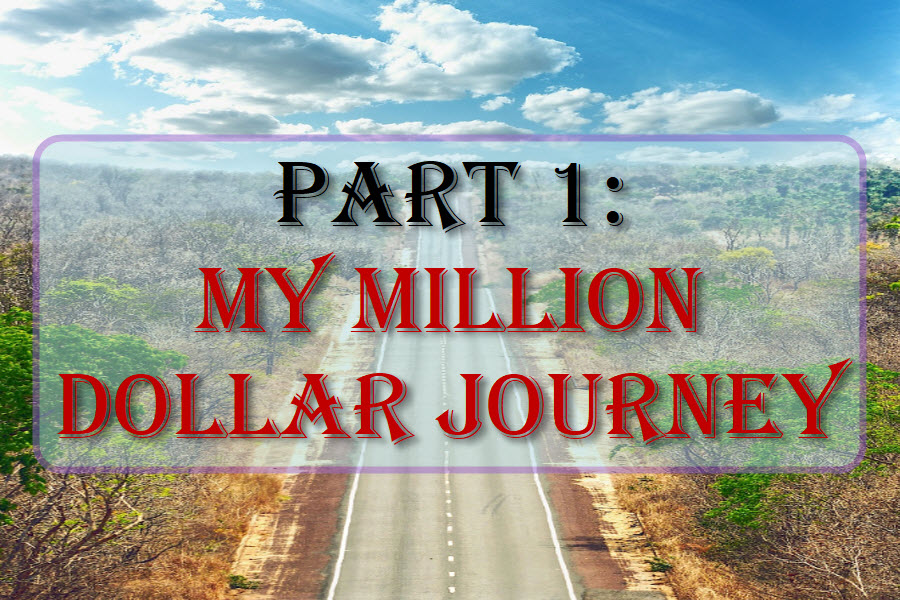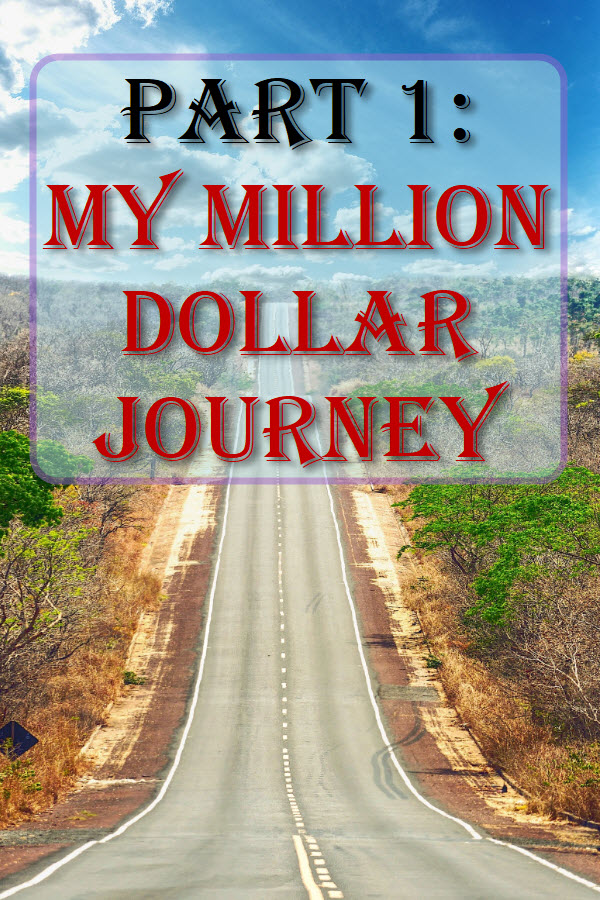
A few years ago, during a casual family dinner conversation, my father-in-law said, “Earning your first bar of gold is the hardest.” I couldn’t remember the exact context of the conversation nor knew the exact meaning of: “bar of gold.” How big is a bar of gold? Is it the size of a piece of Wrigley gum or the size of a house brick? It was just a metaphor that represented the successful achievement of a major financial goal, which was difficult to quantify. However, that metaphor motivated me and I was determined to earn my first bar of gold (for those who are interested to know, a standard gold bar is about 400 troy-ounce, which is equivalent to about $633,798 Canadian dollars as of December 1st, 2016) and quantify my metaphoric bold bar to a million bucks. That was the inception of my first major financial goal.
The slow start
The beginning of my quest to earn a million bucks didn’t start at the point where I had the epitome. I believe it started way before that – after my graduation from the University of Waterloo, back in 2003. Why that point? I consider that point in my life to be the time that I joined the real world or the workforce or whatever you call it. I got a terrible start to that new life. I was saddled with more than $30,000 in student loan debt after graduation (that meant I was worth less than nothing), had no job (did anyone remember the dot.com bust?), needed to maintain a car and a girlfriend (what??? having a girlfriend was expensive when you were unemployed). Finding employment wasn’t easy and it was frustrating. I applied for any job that I think I qualified and attended numerous interviews. I went to a few multiple-round interviews, but no job offer. The reality of the real world wasn’t kind at all.
My first big break
After about ten months of searching, I finally landed my first full-time job in Barrie, Ontario. Fortuitously, the position was for an intermediate application developer for a web content management company, which was in my field of study – information technology. The starting salary was a meager $35,000 per year with two weeks of vacation, non-existent benefits and a six-month probation period. However, I was happy and content that I finally got the opportunity to showcase my skills. After a week of exhausting commuting from Toronto to Barrie, I decided to move to Barrie and be closer to where I worked. In a period of four months, I got settled and acquired my first technical certification, “Advanced Macro Media ColdFusion MX Developer.” and my first annual pay raise of $2,500. Things were starting to look up and I was excelling at my first job.
My second big break
I started to feel homesick and lonely after spending almost a year in Barrie. When a contract opportunity to work for a major Canadian financial institution at downtown Toronto presented itself during the summer of 2004, I jumped at the opportunity and moved home. At first, I was paid $30/hour as a contractor and turned full-time about half a year later. My starting salary was $55,000 per year (a fat 46% pay raise over my last job), I had full dental and health benefits, an Employee Share Ownership Plan (ESOP) that gives me a 50% matching for every dollar that I contributed to my ESOP, up to 6% of my annual salary. On top of that, I got three weeks of vacation and my employer pays me an annual bonus of about 8% of my annual salary, depending partially on my own, my department’s and the organization’s performance. This was the first time that put any serious thought into taking advantage of the benefits of my work perks, saving money and building a solid financial future.
Accumulating assets and debts
Over the next two and a half years, I was able to pay off my $30,000 of student loans (I was finally worth something), built up a saving of about $30,000 in my RRSP account. During this time, I did not do anything out of the extraordinary at all as I was still new to the personal finance concept. I just ensured that I maximized the contribution limits for my ESOP, RRSP and directed all my annual bonus money to my RRSP account and squirrel away my tax refunds toward a down payment for a house. By the spring of 2007, my girlfriend (who is now my wife) and I saved about $35,000, borrowed $20,000 from my mom and $5,000 from my future father-in-law (both loans were interest free) and bought a tiny 1,034 square feet, three bedroom home in Markham, Ontario for about $282,0000 (housing was still affordable during this time). We got engaged and moved into our new house (there was no way that my future father-in-law was going to let my girlfriend move in with me if we were not at least engaged.) At that time, we had very little assets ($45,000 of saving in my RRSP account and $56,000 in equity in our first home) and a ton of debt. We had a $226,000 mortgage, $25,000 in personal loans, and my fiancee still had $10,000 in student loans and a $15,000 first home buyer’s RRSP loan (technically, this was not a loan, but a dollar amount that she had to contribute into her RRSP account within the next 15 years as she withdrew that amount from her RRSP to buy our house). The good news from moving in together was the pooling of resources and the sharing of bills. Instead of earning income and paying bills individually, we became the awesome and powerful tag team that was ready to build assets and destroy debts (wow, that felt like an introduction to the WWE tag team championship match).
The Financial Crisis hit
Once we moved into the new house together, I somehow became obsessed with personal finance and investment. The BNN channel was constantly on at my house, and I started researching about value investing by reading quite a few of Warren Buffett’s annual letter to shareholders. At this point, I decided that if I was going to be investing for myself (and my future wife), I’ve got to learn from the best (it was more like copying from the best) investor. So I took out a $50,000 Home Equity Line of Credit and opened a self-managed trading account during the summer of 2008 and started investing by applying the value investing principles. At the same time, I’ve also changed my employment from one major Canadian financial institution to another. This time, the financial gain from changing employment was minimal. However, I went from being an IT Solutions Developer to a Senior Application Developer and this would pave the way for my next gig. By late summer, I got married (and life was over. Well, not quite yet. Life was pretty much the same except that we got a piece of paper that said we were husband and wife.) Suddenly, the worst global Financial Crisis stormed in. The financial markets around the world crashed and investors were selling anything and everything indiscriminately (the hotshots in the investment industry call these behaviours: “throwing the baby out with the bathwater.”) By the end of 2008, I’ve lost more than 20% of my initial investments. What a horrible time to be a novice investor. Even though there were a lot of panic around the world and I was under some serious stress due to my investments’ performance, I did not wilt and continue to hold on to my investments and long-term strategy. My net worth took a bit of a hit, but it was still worth around $100,000 (this was the time that I started tracking my net worth).
Will I bounce back from one of the worst global financial events or will I lose my shirt in the process? Tune in next time to Part 2: My Million Dollar Journey.


 About Leo
About Leo
What a terrible time to be a novice investor. Depending on when you got into the market, the financial crisis could have been a great opportunity or a great disaster. By looking at the title, I guess it’s the former.
It was terrible as I had a few things working against me. First, I had limited capital to start with. Secondly, I was using margin. Third, my finance was stretched and I didn’t have any wiggle room for errors. Lucky for me, I was able to pull through. Otherwise, I would have been in quite of a mess if I didn’t.
We all need a big break or two in our career. Great perseverance during the first few months of your job search. Did you ever wonder how the trajectory of your career will be if you landed one of the jobs that was not in your field?
Funny that you asked. There is a shoe store that is closed to my current work place and I walk pass it pretty often. Every time I walked pass that store, I felt fortunate that they didn’t hire me after I had gone through four rounds of interviews. It life would had been totally different if I was hired by that shoe company.